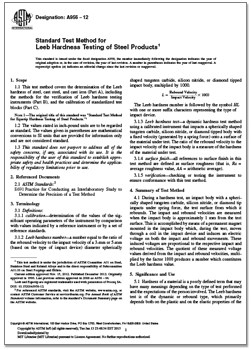英文名称:
ASTM A956-12
Standard Test Method for Leeb Hardness Testing of Steel Products
中文名称:
ASTM A956-12
钢质产品标准里氏硬度试验试验方法
代号说明:
This standard is issued under the fixed designation A956; the number immediately following the designation indicates the year of original adoption or, in the case of revision, the year of last revision. A number in parentheses indicates the year of last reapproval. A superscript epsilon (ε) indicates an editorial change since the last revision or reapproval.
版本说明:
1 This test method is under the jurisdiction of ASTM Committee A01 on Steel, Stainless Steel and Related Alloys and is the direct responsibility of Subcommittee A01.06 on Steel Forgings and Billets.
Current edition approved Nov. 15, 2012. Published December 2012. Originally approved in 1996. Last previous edition approved in 2006 as A956 – 06.
Leeb and Equotip are registered trademarks used with permission of Proceq SA.DOI: 10.1520/A0956-12.
2 For referenced ASTM standards, visit the ASTM website, www.astm.org, or contact ASTM Customer Service at service@astm.org. For Annual Book of ASTM Standards volume information, refer to the standard’s Document Summary page on the ASTM website.
标准正文:
1. Scope
1.1 This test method covers the determination of the Leeb hardness of steel, cast steel, and cast iron (Part A), including the methods for the verification of Leeb hardness testing instruments (Part B), and the calibration of standardized test blocks (Part C).
NOTE 1—The original title of this standard was “Standard Test Method for Equotip Hardness Testing of Steel Products.”
1.2 The values stated in inch-pound units are to be regarded as standard. The values given in parentheses are mathematical conversions to SI units that are provided for information only and are not considered standard.
1.3 This standard does not purport to address all of the safety concerns, if any, associated with its use. It is the responsibility of the user of this standard to establish appropriate safety and health practices and determine the applicability of regulatory limitations prior to use.
2. Referenced Documents
2.1 ASTM Standards:
E691 Practice for Conducting an Interlaboratory Study to Determine the Precision of a Test Method
3. Terminology
3.1 Definitions:
3.1.1 calibration—determination of the values of the significant operating parameters of the instrument by comparison with values indicated by a reference instrument or by a set of reference standards.
3.1.2 Leeb hardness number—a number equal to the ratio of the rebound velocity to the impact velocity of a 3-mm or 5-mm (based on the type of impact device) diameter spherically shaped tungsten carbide, silicon nitride, or diamond tipped impact body, multiplied by 1000.
L=Rebound Velocity/Impact Velocity*1000
The Leeb hardness number is followed by the symbol HL with one or more suffix characters representing the type of impact device.
3.1.3 Leeb hardness test—a dynamic hardness test method using a calibrated instrument that impacts a spherically shaped tungsten carbide, silicon nitride, or diamond tipped body with a fixed velocity (generated by a spring force) onto a surface of the material under test. The ratio of the rebound velocity to the impact velocity of the impact body is a measure of the hardness of the material under test.
3.1.4 surface finish—all references to surface finish in this test method are defined as surface roughness (that is, Ra = average roughness value, AA = arithmetic average).
3.1.5 verification—checking or testing the instrument to ensure conformance with this test method.
在线阅读 免费下载







